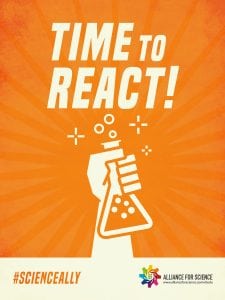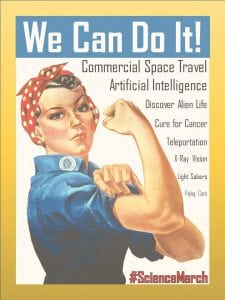When I first set out to become a scientist I had little interest in politics. As an undergraduate student studying biology, I naively assumed that science was a universally appreciated field. After all, despite artificial borders, we all drink the same water and breathe the same air. Cancer, heart disease, and strokes treat conservatives and progressives equally. But after many years of depending on US government funding for research in academia, I’ve learned that science and politics are inextricably linked. The budget of the National Institute of Health, the largest funder of biomedical research in the world, is currently slated to lose $5.8 billion (~18%) of its 2018 budget under the new U.S. administration (Reardon et al. 2017). The Paris Agreement, which unites over 190 nations in a common effort to mitigate the effects of climate change, is at the mercy of the environmental regulations enacted (or redacted) by each nation’s government (United Nations 2016). In learning that the boundaries of science are not limited by scientists, but by government and politics, I realized that I have only been doing half of my job as a scientist. It is not enough to simply do science. We must also advocate for science. As science students, professionals, and enthusiasts, we are the greatest weapons in the fight to save science.
Science is not just the work of people in white lab coats looking through microscopes. Chemistry, agriculture, drug development, engineering, data science, and any other field that builds knowledge based on systematic experimentation and the quantitative fact is a science. Historically, these fields have had a substantial impact on government policy. Research in environmental science informs decisions on issues such as pesticide use, city air pollution limits, and water treatment standards. Research in chemistry and biology impacts regulations on food safety and drug efficacy made by organizations such as the Medicines and Healthcare products Regulatory Agency in the U.K. and the Food and Drug Administration in the U.S. Without science, there is no evidence on which to base policy. Yet legislation is often still developed without regard for (or in spite of) evidence. Despite scientific consensus on the theory of evolution, many public schools in the U.S. allow teachers to teach creationism as an “alternative” to evolution. Likewise, many global powers continue to prioritize economic policy over efforts to curb climate change, despite overwhelming evidence that climate change is anthropogenic and will have negative global impacts for decades to come.

The crumbling relationship between science and politics galvanized scientists and science supporters in over 400 cities across the globe to unite in a non-partisan March for Science on April 22nd to highlight the importance of evidence-based policy. In a healthy relationship between science and politics, voters would be educated on scientific issues and would take these matters into consideration when electing individuals to represent their interests. Elected officials would also be scientifically literate and represent the interests of their constituents, and would thus advocate for evidence-based policies that are best for the people. Yet people often ignore scientific evidence when forming opinions about science policy and when electing opinions. Numerous political and social science studies have found that opinions on scientific issues are heavily influenced by existing beliefs, religion, and political party or ideology (Blank and Shaw 2015; Pew Research Center 2015; Mervis 2015). The resulting dissonance between public opinion and scientific evidence impacts policies on issues ranging from how government funds are allocated for scientific research to how science is taught in schools. While many of the factors contributing to this may be out of the direct control of scientists, we do have power over one of the most influential factors: science communication. The single greatest way to impact science policy is by imparting the importance of science to the public — by influencing policy through the people.
We can no longer leave science communication up to those in the mass media or politics. While science journalism is critical to the dissemination of science to the public, those with preexisting perceptions based on non-scientific factors are difficult to reach with this medium. To reach greater numbers more effectively, we must take upon ourselves the responsibility of protecting and promoting science. Rejection of science is most likely to occur on issues where scientific evidence seems directly opposed to personal or religious beliefs or where it involves self-sacrifice (Blank and Shaw 2015; Pew Research Center 2015; Mervis 2015).
To combat this, we must emphasize the ways in which science can be integrated with established beliefs and routines, and highlight the ways in which people personally benefit from science. If you are a scientist, you can do this by explaining your research and its impacts to as wide a range of non-scientists as possible. When you do so, be specific and focus on the impact of your work and how it fits into the ideology of your audience. Don’t skip the “boring” details, either. By glossing over grueling tasks such as applying for grants and engaging in the peer-reviewed publication process, we fail to convey how rigorous our studies must be to be funded or published and reduce the perceived value of our research. Another immensely valuable way to share scientific data is by publishing in open access journals or pre-publishing in free online archives, eliminating the need for expensive journal subscriptions to view current scientific research.

If you are a science student, explain your course material or research projects to family, friends, and co-workers; this has the added bonus of helping you to learn the material better. If you are a science teacher, enthusiast, illustrator, or citizen scientist, let people know! Use social media to share interesting laboratory experiments, illustrations, or blogposts with a wider audience. In the typical jargon-filled journal article format, science can be intimidating. Using social media platforms as outlets brings science to the people in a more familiar and inviting format. Sharing eye-catching photos of colorimetric reactions or fluorescence microscopy images can be a surprisingly effective way of starting a conversation about the importance of funding environmental or biomedical research. We may not be science journalists, but we are the people on the front lines of science. Learning about science informally through the experiences of people in the field can be much more personal and impactful than hearing about it from a journalist or news anchor.
In addition to talking about science, we must also act for science. While the March for Science sent a strong message to onlookers around the world, we must also actively share science within our own communities. Easy ways to do this include submitting op-eds to local newspapers, attending town hall meetings, or volunteering at local schools, libraries, and museums. Submit summaries of scientific articles to local publications. Give demonstrations or talks at community events. Whichever community platform you choose, it is important to tailor your message to your audience, as not everyone will be receptive to the same message. A rural farming community will likely be less interested in a talk on genome editing than in an explanation of how science enhances farming technologies or animal breeding practices. Yet everyone benefits from science in some way, so our message is for everyone.
However, we choose to advocate, it is imperative that we make meaningful connections between people and science. By communicating to broader audiences in more personal ways, we may begin to heal the dissonance between science and politics. Whether or not you participated in the March for Science, it is vital to unite with other scientists to defend its most powerful slogan: Science not Silence.
References:
Blank, JM and D Shaw. 2015. Does partisanship shape attitudes toward science and public policy? The case for ideology and religion. The Annals of the American Academy of Political and Social Science 658: 18-35.
Funk, C and L Rainie. 2015. Americans, Politics and Science Issues. Pew Research Center. https://www.pewinternet.org/2015/07/01/ americans-politicsand-science-issues/. Accessed on April 16,2017.
Mervis, J. 2015. Politics, science, and public attitudes: what we’re learning, and why it matters. Science. https://www.sciencemag.org/news/2015/02/politicsscienceandpublic-attitudeswhatwe-relearningand-why-it-matters. Accessed on April 21, 2017.
Reardon, S, J Tolleson, A Witze and E Ross. 2017. US science agencies face deep cuts in Trump budget. Nature News 543. https://www.nature.com/news/usscienceagenciesface-deep-cutsintrumpbudget-1.21652. Accessed on April 21, 2017.
United Nations. 2016. Paris Agreement. United Nations Treaty Collection.






